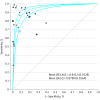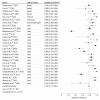Accuracy and Methodologic Challenges of Volatile Organic Compound-Based Exhaled Breath Tests for Cancer Diagnosis: A Systematic Review and Meta-analysis
- PMID: 30128487
- PMCID: PMC6439770
- DOI: 10.1001/jamaoncol.2018.2815
Accuracy and Methodologic Challenges of Volatile Organic Compound-Based Exhaled Breath Tests for Cancer Diagnosis: A Systematic Review and Meta-analysis
Erratum in
-
Errors in Figure 3.JAMA Oncol. 2019 Jul 1;5(7):1070. doi: 10.1001/jamaoncol.2019.1362. JAMA Oncol. 2019. PMID: 31120523 Free PMC article. No abstract available.
Abstract
Importance: The detection and quantification of volatile organic compounds (VOCs) within exhaled breath have evolved gradually for the diagnosis of cancer. The overall diagnostic accuracy of proposed tests remains unknown.
Objectives: To determine the diagnostic accuracy of VOC breath tests for the detection of cancer and to review sources of methodologic variability.
Data sources: An electronic search (title and abstract) was performed using the Embase and MEDLINE databases (January 1, 2000, to May 28, 2017) through the OVID platform. The search terms cancer, neoplasm, malignancy, volatile organic compound, VOC, breath, and exhaled were used in combination with the Boolean operators AND and OR. A separate MEDLINE search that used the search terms breath AND methodology was also performed for studies that reported factors that influenced the concentration of VOCs within exhaled breath in humans.
Study selection: The search was limited to human studies published in the English language. Trials that analyzed named endogenous VOCs within exhaled breath to diagnose or assess cancer were included in this review.
Data extraction and synthesis: Systematic review and pooled analysis were conducted in accordance with the recommendations of the Cochrane Library and Meta-analysis of Observational Studies in Epidemiology guidelines. Bivariate meta-analyses were performed to generate pooled point estimates of the hierarchal summary receiver operating characteristic curve of breath VOC analysis. Included studies were assessed according to the Standards for Reporting of Diagnostic Accuracy Studies checklist and Quality Assessment of Diagnostic Accuracy Studies 2 tool.
Main outcomes and measures: The principal outcome measure was pooled diagnostic accuracy of published VOC breath tests for cancer.
Results: The review identified 63 relevant publications and 3554 patients. All reports constituted phase 1 biomarker studies. Pooled analysis of findings found a mean (SE) area under the receiver operating characteristic analysis curve of 0.94 (0.01), sensitivity of 79% (95% CI, 77%-81%), and specificity of 89% (95% CI, 88%-90%). Factors that may influence variability in test results included breath collection method, patient physiologic condition, test environment, and method of analysis.
Conclusions and relevance: The findings of our review suggest that standardization of breath collection methods and masked validation of breath test accuracy for cancer diagnosis is needed among the intended population in multicenter clinical trials. We propose a framework to guide the conduct of future breath tests in cancer studies.
Conflict of interest statement
Figures



Comment in
-
Clinical Application of Volatile Organic Compound-Based Exhaled Breath Tests for Cancer Diagnosis.JAMA Oncol. 2019 Jul 1;5(7):1068-1069. doi: 10.1001/jamaoncol.2019.1143. JAMA Oncol. 2019. PMID: 31120474 No abstract available.
-
Clinical Application of Volatile Organic Compound-Based Exhaled Breath Tests for Cancer Diagnosis-In Reply.JAMA Oncol. 2019 Jul 1;5(7):1069. doi: 10.1001/jamaoncol.2019.1158. JAMA Oncol. 2019. PMID: 31120476 No abstract available.
References
-
- Environmental Protection Agency Definition of Volatile Organic Compound. July 1, 1978. https://www3.epa.gov/ttn/naaqs/aqmguide/collection/Doc_0016_VOC330701781.... Accessed June 12, 2018.
Publication types
MeSH terms
Substances
Grants and funding
LinkOut - more resources
Full Text Sources
Other Literature Sources
Medical

